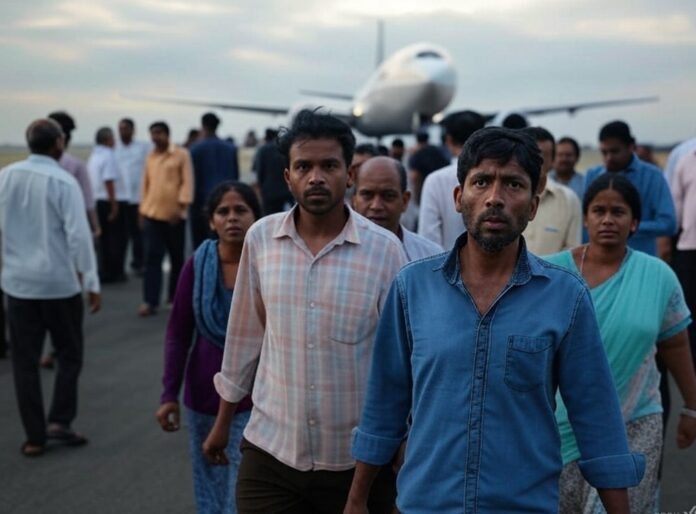
Shifting Politics and Growing Concerns: The Deportation of Undocumented and Unauthorized Indian Nationals – 3RD Largest Unauthorized Group After Mexico
By Samuel A. Lopez
[SAN FRANCISCO, CA] –
As part of President Donald Trump’s broader plan to deport illegal immigrants, the U.S. government has targeted undocumented and unauthorized H-1B visa holders from India, focusing on those living in the U.S. illegally or on expired visas.
Hundreds have already been quietly deported and are back home, with tens of thousands more undocumented Indian nationals set to be deported in the coming weeks and months.
This mass deportation plan is set to expel over 20,000 undocumented Indians who are living in the U.S. without proper documentation. The sweeping deportation process comes as Trump keeps his election promise to remove over 17 million unauthorized workers in the country.
According to the Pew Research Center, Indians made up the third-largest group of unauthorized immigrants in the U.S. in 2022, behind Mexico and El Salvador, with approximately 725,000 Indians currently in the U.S. on H-1B visas.
For months, immigration officials have identified and marked over 20,000 undocumented Indians for deportation, many of whom are residing in the U.S. on expired visas.
At least 20,407 undocumented Indians are potentially on the Trump administration’s radar. Of these, 17,940 are under “final removal orders,” while another 2,467 are in detention with the Enforcement and Removal Operations (ERO) of U.S. Immigration and Customs Enforcement (ICE).
Since early January, U.S. authorities began deporting hundreds of Indian migrants, and more deportations are expected in the coming weeks. These individuals, some of whom are tech professionals on expired and invalid visas, are being sent back to India in an operation that has already resulted in the arrival of several planes carrying deported nationals.
When recently questioned on these deportations, U.S. Secretary of State Marco Rubio responded that “These deportation flights are an effective way to curb illegal migration.”
The timing of this wave of deportations coincides with several significant shifts within the tech industry. Silicon Valley companies, which have long relied on foreign labor—particularly from India and China—are now grappling with major layoffs. Many of these displaced workers are on H-1B visas, which require them to secure new employment sponsorship to remain in the country legally. But with mass layoffs across major tech companies and an increasing demand for roles that are not easily filled by international workers, these visa holders are finding it increasingly difficult to maintain their status.
Once hailed as “Computer Scientists,” “Software Engineers,” or “Cloud Solutions Visionaries,” many foreign tech workers have now found themselves in a rapidly changing environment.
Artificial intelligence, which has evolved dramatically in recent years, is increasingly replacing roles that were once occupied by human H-1B visa workers, making their specialty skills, not so special anymore, and making many of these positions obsolete. As a result, a large number of foreign workers are facing deportation as they fail to find new sponsors before their visas expire.
While Trump’s mass deportation strategy targets states across the country, California, with its sanctuary cities and liberal immigration policies, has been at the forefront of the conflict. Governor Gavin Newsom’s strong stance on protecting undocumented immigrants has drawn Trump’s ire, and California’s Bay Area, the heart of Silicon Valley, has become a key battleground.
The conflict between Trump’s deportation efforts and California’s sanctuary policies has intensified, with the state now a focal point for federal immigration agents. As the deportation plan continues to unfold, both the tech industry and the U.S. political landscape are being forced to reckon with the consequences of illegal immigration and the limits of visa programs.
As the deportations ramp up, President Trump’s administration has found an unexpected ally in the Indian government. Indian Prime Minister Narendra Modi is scheduled to visit the U.S. on February 12th, and the issue of deporting undocumented Indian nationals is likely to be one of the key topics discussed.
India has expressed a willingness to cooperate with the U.S. in facilitating the return of its undocumented citizens. Foreign Minister Subrahmanyam Jaishankar confirmed that India is open to the idea of accepting deported nationals, which may smooth the process for Trump’s broader deportation plans.
The H-1B visa program has long been a focal point of debate in the U.S. Critics argue that it disproportionately benefits foreign workers while undercutting American workers, especially in the tech sector. Some contend that the inflated job titles used to justify hiring H-1B workers and “specialty skilled” foreign nationals—such as “Cloud Solutions Architect“ or “Data Optimization Specialist”—serve only to create a loophole for employers to bypass hiring American talent.
On the other hand, proponents of the program argue that it is crucial for maintaining U.S. competitiveness in global innovation, particularly in fields like AI and software engineering. The program’s defenders emphasize that foreign workers provide vital expertise that U.S. companies need to remain competitive in the ever-evolving tech landscape.
With President Trump’s focus on reducing the number of illegal immigrants in the country, the H-1B visa program remains a key issue in the broader debate about immigration reform.
Fact-Check Section





